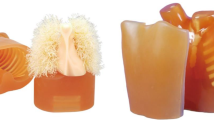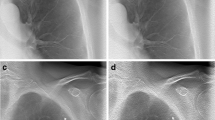Abstract
Background
A radiation dose of any magnitude can produce a detrimental effect manifesting as an increased risk of cancer. Cancer development may be delayed for many years following radiation exposure. Minimizing radiation dose in children is particularly important. However, reducing the dose can reduce image quality and may, therefore, hinder lesion detection.
Objective
We investigated the effects of reducing the image signal-to-noise ratio (SNR) on CT lung nodule detection for a range of nodule sizes.
Materials and methods
A simulated nodule was placed at the periphery of the lung on an axial CT slice using image editing software. Multiple copies of the manipulated image were saved with various levels of superimposed noise. The image creation process was repeated for a range of nodule sizes. For a given nodule size, output images were read independently by four Fellows of The Royal College of Radiologists.
Results
The overall sensitivities in detecting nodules for the SNR ranges 0.8–0.99, 1–1.49, and 1.5–2.35 were 40.5%, 77.3% and 90.3%, respectively, and the specificities were 47.9%, 73.3% and 75%, respectively. The sensitivity for detecting lung nodules increased with nodule size and increasing SNR. There was 100% sensitivity for the detection of nodules of 4–10 mm in diameter at SNRs greater than 1.5.
Conclusion
Reducing medical radiation doses in children is of paramount importance. For chest CT examinations this may be counterbalanced by reduced sensitivity and specificity combined with an increased uncertainty of pulmonary nodule detection. This study demonstrates that pulmonary nodules of 4 mm and greater in diameter can be detected with 100% sensitivity provided that the perceived image SNR is greater than 1.5.












Similar content being viewed by others
References
Pierce DA, Preston DL (2000) Radiation-related cancer risks at low doses among atomic bomb survivors. Radiat Res 154:178–186
Kleinerman RA (2006) Cancer risks following diagnostic and therapeutic radiation exposure in children. Pediatr Radiol 36 [Suppl 14]:121–125
Brenner D, Elliston CD, Hall EJ et al (2001) Estimated risks of radiation-induced fatal cancer from pediatric CT. AJR 176:289–296
Slovis TL (2003) Children, computed tomography radiation dose, and the As Low As Reasonably Achievable (ALARA) concept. Pediatrics 112:971–972
Higson D (2005) BEIR VII-2. J Radiol Prot 25:324–325
Regier M, Kandel S, Kaul MG et al (2007) Detection of small pulmonary nodules in high-field MR at 3T: evaluation of different pulse sequences using porcine lung explants. Eur Radiol 17:1341–1351
Schroeder T, Rueham SG, Debatin JF et al (2005) Detection of pulmonary nodules using a 2D HASTE MR sequence: comparison with MDCT. AJR 185:979–984
Ginsberg MS, Griff SK, Go BD et al (1999) Pulmonary nodules resected at video-assisted thoracoscopic surgery: etiology in 426 patients. Radiology 213:277–282
Robertson PL, Boldt DW, De Campo JF (1988) Paediatric pulmonary nodules: a comparison of computed tomography, thoracotomy findings and histology. Clin Radiol 39:607–610
McCarville MB, Leaderman HM, Santana VM et al (2006) Distinguishing benign from malignant pulmonary nodules with helical chest CT in children with malignant solid tumors. Radiology 239:514–520
Donnelly LF (2005) Reducing radiation dose associated with pediatric CT by decreasing unnecessary examinations. AJR 184:655–657
Siegel MJ, Schmidt B, Bradley D et al (2004) Radiation dose and image quality in pediatric CT: effect of technical factors and phantom size and shape. Radiology 233:515–522
Boone JM, Geraghty EM, Siebert JA et al (2003) Dose reduction in pediatric CT: a rational approach. Radiology 228:352–360
Donnelly LF, Emery KH, Brody AS et al (2001) Minimizing radiation dose for pediatric body applications of single-detector helical CT: strategies at a large children’s hospital. AJR 176:303–306
Robinson AE, Hill EP, Harpen MD (1986) Radiation dose reduction in pediatric CT. Pediatr Radiol 16:53–54
Haaga JR, Miraldi F, MacIntyre W et al (1981) The effect of mAs variation upon computed tomography image quality as evaluated by in vivo and in vitro studies. Radiology 138:449–454
Båth M, Håkansson M, Börjesson S et al (2005) Nodule detection in digital chest radiography: part of image background acting as pure noise. Radiat Prot Dosimetry 114:102–108
Kimme-Smith C, Aberle DR, Sayre JW et al (1995) Effects of reduced exposure on computed radiography: comparison of nodule detection accuracy with conventional and asymmetric screen-film radiographs of a chest phantom. AJR 165:269–273
Urbaniak G, Plous S (2007) Research randomizer. http://www.randomizer.org. Cited 5 May 2007
Donnelly LF, Frush DP (2001) Fallout from recent articles on radiation dose and pediatric CT. Pediatr Radiol 31:388; discussion 389–391
Paterson A, Frush DP, Donnelly LF (2001) Helical CT of the body: are settings adjusted for pediatric patients? AJR 176:297–301
Brenner DJ, Elliston CD, Hall EJ et al (2001) Estimates of the cancer risks from pediatric CT radiation are not merely theoretical: comment on “point/counterpoint: in x-ray computed tomography, technique factors should be selected appropriate to patient size. against the proposition”. Med Phys 28:2387–2388
Hollingsworth C, Frush EP, Cross M et al (2003) Helical CT of the body: a survey of techniques used for pediatric patients. AJR 180:401–406
Curry TS, Dowdey JE, Murry RC (1990) Christensen’s physics of diagnostic radiology, 4th edn. Lea and Febiger, Philadelphia
Fefferman NR, Bomsztyk E, Yim AM et al (2005) Appendicitis in children: low-dose CT with a phantom-based simulation technique – initial observations. Radiology 237:641–646
Mayo JR, Whittal KP, Leung AN et al (1997) Simulated dose reduction in conventional chest CT: validation study. Radiology 202:453–457
Frush DP, Slack CC, Hollingworth CL et al (2002) Computer-simulated radiation dose reduction for abdominal multidetector CT of pediatric patients. AJR 179:1107–1113
Papaioannou G, Young C, Owens CM (2007) Multidetector row CT for imaging the paediatric tracheobronchial tree. Pediatr Radiol 37:515–529
Paterson A, Frush DP (2007) Dose reduction in paediatric MDCT: general principles. Clin Radiol 62:507–517
Kaste SC, Pratt CB, Cain AM et al (1999) Metastases detected at the time of diagnosis of primary pediatric extremity osteosarcoma at diagnosis: imaging features. Cancer 86:1602–1608
Su WT, Chewning J, Abramson S et al (2004) Surgical management and outcome of osteosarcoma patients with unilateral pulmonary metastases. J Pediatr Surg 39:418–423; discussion 418–423
Wyttenbach R, Vock P, Tschappeler H (1998) Cross-sectional imaging with CT and/or MRI of pediatric chest tumors. Eur Radiol 8:1040–1046
Grundy P, Perlman E, Rosen NS et al (2005) Current issues in Wilms tumor management. Curr Probl Cancer 29:221–260
Acknowledgement
This work was undertaken at the Comprehensive Biomedical Centre, University College Hospital London, which received a proportion of the funding from the National Institute for Health Research. The views expressed in this publication are those of the authors and not necessarily those of the UK Department of Health. The authors are particularly grateful to Dr. Penny Shaw, Dr. Duncan Brennand and Dr. Sivadas Ganeshalingam for their help with the study.
Author information
Authors and Affiliations
Corresponding author
Rights and permissions
About this article
Cite this article
Punwani, S., Zhang, J., Davies, W. et al. Paediatric CT: the effects of increasing image noise on pulmonary nodule detection. Pediatr Radiol 38, 192–201 (2008). https://doi.org/10.1007/s00247-007-0694-8
Received:
Revised:
Accepted:
Published:
Issue Date:
DOI: https://doi.org/10.1007/s00247-007-0694-8




